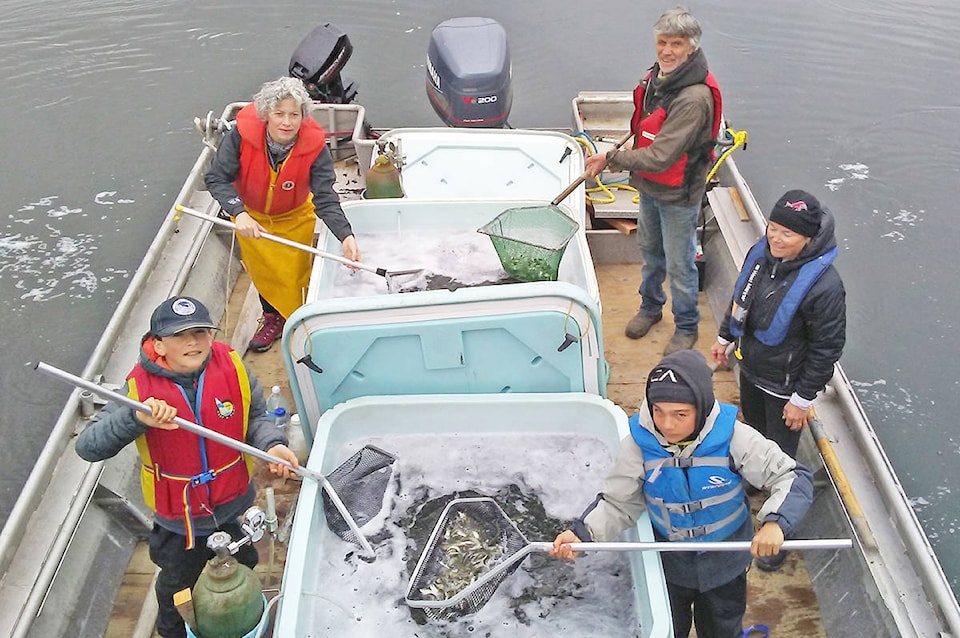The Tofino Hatchery recently released the last of its coho salmon, bringing an end to a season that saw Clayoquot Sound’s watersheds enhanced with roughly 200,000 fish.
Hatchery manager Doug Palfrey told the Westerly News that 62,000 coho were released into Cypre River on June 4’s season wrap-up, thanks to help from a tug and barge donated by G&N Towing. Palfrey said G&N has been offering its services to the hatchery for free for over 30 years.
Armed with just $8,000 of annual funding from the Department of Fisheries and Oceans Canada, the hatchery relies on local donations and volunteers to get the job done.
Palfrey said about 20 volunteers completed the final coho release, scattering the young salmon throughout the river where the coho will stay for about a year before heading into the ocean.
“We drive over in trucks and transport tanks with a bunch of volunteers and then we hike down the river with backpacks full of fish to all these different sites,” he said. “It’s far too many fish for one spot, so you must spread them out over, if you can, the entire length of the river.”
Palfrey has been enhancing chinook and coho populations in Clayoquot Sound with the hatchery for 33 years and said the funding he’s received from DFO has stayed stagnant. He suggested the $8,000 the hatchery receives should be closer to $100,000 to reverse declining chinook returns.
“The price of gas goes up, the price of fish food, hydro, all that stuff and DFO is nowhere near aligning themselves with any increase. We’re pretty much forgotten about at the end of the road,” he said. “We’ve got 13 chinook systems in Clayoquot Sound so we move around where it’s needed most. You could quite easily enhance all the chinook stocks because they’re all very low.”
He noted that the hatchery was able to revitalize Tranquil Creek 25 years ago, bringing its return up from under 100 to 2,100, but then moved on to focus its efforts on Cypre River, returning its return from under 100 to 3,700 and did not have enough funds to enhance both systems at the same time.
“The sad part in all this is, when we dropped Tranquil, it ended up going down right back to when we started enhancing it,” he said. “Last year we got 59 chinook.”
He added much of the work is done by accessing abandoned logging camps and roads which hatchery staff and volunteers must maintain.
“There’s a lot of players to pull the whole project together, there’s a lot of networking that you have to do,” he said. “You’ve got a lot of hurdles when you’re working on remote rivers. You’ve got vehicle breakdowns. You’ve got trees across the road. I travel with a chainsaw all fall for my work. I never leave the hatchery without a chainsaw because you invariably have to cut your way in, or there’s been days we have to cut trees to come back out.”
He said the hatchery does its best to recruit volunteers and inspire local passions for salmon stewardship and he was ecstatic to find two local 12-year-olds, Phoenix Greig and Ethan Stere, each eager to lend their hands. He said Greig and Stere helped with the hatchery’s collection in October and stayed engaged throughout the season.
“There was ice everywhere and we had to hike a long way up the river and take a boat and drag rafts and nets and they were just little troopers in the freezing cold,” he said. “They also came down every weekend in the spring for two months and they did feeding nad cleaning. I even got them anaesthetizing fish, weighing and measuring the length and adjusting the feed rate. They’re totally hooked on fish and it’s fantastic. You don’t often get that enthusiasm every single weekend.”
He said the hatchery’s efforts are vital because chinook populations are being threatened by overfishing and climate change and added that he’s hopeful the populations will rebound as long as some pressure is taken off from harvesting.
“If you give those things half a chance, they will go to the ‘nth degree’ to get up those rivers,” he said. “There’s hope, they just need to be given a chance.”
andrew.bailey@westerlynews.ca
Like us on Facebook and follow us on Twitter
READ MORE: Salmon populations “drastically declining” around Tofino and Ucluelet
READ MORE: Tofino and Ucluelet facing likely fishing closures in 2019
